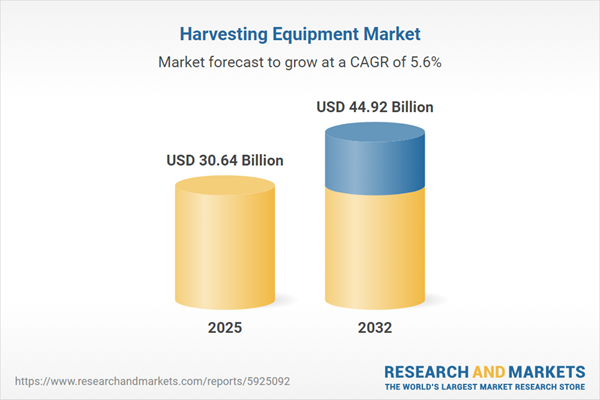Speak directly to the analyst to clarify any post sales queries you may have.
The harvesting equipment market is evolving rapidly as senior leaders and procurement professionals adapt strategies to navigate technological integration, shifting supply chain models, and increasing operational demands.
Market Snapshot: Harvesting Equipment Market Size and Growth Trends
The global harvesting equipment market is projected to grow from USD 29.02 billion in 2024 to USD 30.64 billion in 2025, representing a compound annual growth rate (CAGR) of 5.61%. Expansion is fueled by continued investment in precision agriculture, evolving harvesting technologies, and a movement toward more energy-efficient equipment solutions. As agricultural operations strive for enhanced productivity and sustainability, procurement professionals are strategizing around dynamic regulations, demographic trends, and value-driven supply chain optimization, all of which are influencing major buying decisions across the sector.
Scope & Segmentation: Comprehensive Analysis of the Harvesting Equipment Market
- Equipment Types: Pull-type and self-propelled combines, complete lines of combine headers, both trailed and self-propelled forage harvesters, and specialized reaper harvesters offer tailored solutions to address varying operational needs across different field conditions.
- Crop Classifications: Equipment engineered for a range of crop categories, including cereals like wheat, barley, rice, as well as oilseeds and pulses, enables broad applicability and adaptability to multiple climate zones and soil types.
- End User Categories: Solutions built for contract harvesters, large-scale agribusinesses, and smallholder producers equip users to manage transitions effectively, addressing scalability, resilience, and sustainable productivity.
- Distribution Channels: Purchasing options via direct manufacturer sales, extensive dealer networks, partnerships with OEMs, and emerging digital procurement platforms deliver buyers the flexibility to select procurement pathways that best fit their operational context.
- Geographic Regions: The market encompasses North America, South America, Europe, the Middle East, Africa, and Asia-Pacific. Regional policies—especially in China, India, Japan, and Southeast Asia—are driving sector-specific infrastructure growth, creating supportive frameworks that propel technology adoption and resource investment.
- Emerging Technologies: The integration of digital sensors, autonomous and machine vision systems, electrified platforms, modular equipment formats, and advanced analytics is supporting compliance with environmental standards and supporting gains in operational efficiency across enterprises.
Key Takeaways: Strategic Insights for Senior Buyers
- The integration of automation and digital controls is streamlining harvest processes, allowing agricultural leaders to standardize production while adapting to a variety of field conditions.
- Increased collaboration among manufacturers, technology providers, and agricultural businesses is improving equipment reliability and maintenance, while accelerating the adoption of data-driven analytics.
- Procurement priorities are shifting toward multi-functional solutions that align with environmental and modernization objectives, supporting both immediate operational needs and long-term sustainability.
- Expanded public and private partnerships, particularly in leading Asian markets, are enhancing technology accessibility for smallholders by deploying shared resource models and improving machinery availability.
- Localization of product development to regional markets is enabling regulatory alignment and responsive aftersales support, strengthening customer service structures and operational continuity for buyers.
Tariff Impact: Navigating Changing Trade Dynamics
Recent changes to United States tariff policies are prompting purchasing organizations to reassess sourcing strategies, prioritizing regional supplier partnerships and diversified procurement channels. Companies are exploring subscription-based equipment models and locally anchored support solutions, enabling continued operations and greater control over supply chain risks in volatile trade conditions.
Methodology & Data Sources
This analysis is grounded in primary research with harvesting equipment manufacturers, major distributors, and agricultural management professionals. Reputable industry association data, regulatory research, academic studies, and expert panel input have supplemented the findings, ensuring robust validation and relevance for executive decision-makers.
Why This Report Matters: Actionable Intelligence for Executive Leaders
- Enables alignment of digital transformation initiatives with sustainability targets in equipment investment strategies, supporting forward-looking decision-making for procurement leaders.
- Facilitates active risk management by providing detailed visibility into shifting technology trends, competitor activities, and supply chain developments, equipping leadership to respond to market challenges.
- Equips senior teams to anticipate regulatory changes, deepen industry partnerships, and implement strategies that strengthen business resilience and promote sustainable sector growth.
Conclusion
This report provides strategic guidance for executive stakeholders seeking to foster adaptability, introduce advanced technologies, and secure sustained operational advantages in the dynamic harvesting equipment market.
Additional Product Information:
- Purchase of this report includes 1 year online access with quarterly updates.
- This report can be updated on request. Please contact our Customer Experience team using the Ask a Question widget on our website.
Table of Contents
3. Executive Summary
4. Market Overview
7. Cumulative Impact of Artificial Intelligence 2025
Companies Mentioned
The companies profiled in this Harvesting Equipment market report include:- Deere & Company
- CNH Industrial N.V.
- AGCO Corporation
- Kubota Corporation
- CLAAS KGaA mbH
- Mahindra & Mahindra Ltd.
- SDF S.p.A.
- Yanmar Co., Ltd.
- ISEKI & CO., LTD.
- Rostselmash Public Joint Stock Company
Table Information
| Report Attribute | Details |
|---|---|
| No. of Pages | 198 |
| Published | November 2025 |
| Forecast Period | 2025 - 2032 |
| Estimated Market Value ( USD | $ 30.64 Billion |
| Forecasted Market Value ( USD | $ 44.92 Billion |
| Compound Annual Growth Rate | 5.6% |
| Regions Covered | Global |
| No. of Companies Mentioned | 11 |









